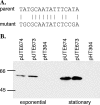plcR papR-independent expression of anthrolysin O by Bacillus anthracis
- PMID: 16980467
- PMCID: PMC1636328
- DOI: 10.1128/JB.00525-06
plcR papR-independent expression of anthrolysin O by Bacillus anthracis
Abstract
Cholesterol-dependent cytolysins (CDCs) are secreted, pore-forming toxins that are associated with pathogenesis in a variety of gram-positive bacteria. Bacillus anthracis produces anthrolysin O (ALO), a CDC that is largely responsible for the hemolytic activity of culture supernates when the bacterium is cultured in appropriate conditions. B. cereus and B. thuringiensis, species closely related to B. anthracis, produce CDCs with significant amino acid sequence homology to ALO. Transcription of the B. cereus and B. thuringiensis CDC genes is controlled by PlcR, a transcription regulator that requires a pentapeptide derived from the papR gene product for binding to a consensus sequence (PlcR box) and transcriptional activation of downstream genes. A PlcR box precedes the B. anthracis alo gene, and the B. anthracis genome contains three plcR-like genes, one of which harbors a nonsense mutation that is predicted to result in a truncated, nonfunctional protein. We detected mRNA of alo, papR, and the three plcR-like genes in spleens of B. anthracis-infected mice, indicating gene expression in vivo. Analysis of alo transcription in batch culture revealed a potential transcription start located between the PlcR box and the translational start. Nevertheless, steady-state levels of alo transcripts and ALO protein were unaffected by deletion of papR or disruption of the PlcR box. Our data indicate that despite the presence of the transcriptionally active plcR and papR genes in B. anthracis and a PlcR box in the promoter region of the alo gene, alo expression is independent of this control system.
Figures






Similar articles
-
A spontaneous translational fusion of Bacillus cereus PlcR and PapR activates transcription of PlcR-dependent genes in Bacillus anthracis via binding with a specific palindromic sequence.Infect Immun. 2004 Oct;72(10):5814-23. doi: 10.1128/IAI.72.10.5814-5823.2004. Infect Immun. 2004. PMID: 15385482 Free PMC article.
-
Activation of the latent PlcR regulon in Bacillus anthracis.Microbiology (Reading). 2010 Oct;156(Pt 10):2982-2993. doi: 10.1099/mic.0.041418-0. Epub 2010 Aug 5. Microbiology (Reading). 2010. PMID: 20688829 Free PMC article.
-
PlcR is a pleiotropic regulator of extracellular virulence factor gene expression in Bacillus thuringiensis.Mol Microbiol. 1999 Jun;32(5):1043-53. doi: 10.1046/j.1365-2958.1999.01419.x. Mol Microbiol. 1999. PMID: 10361306
-
What sets Bacillus anthracis apart from other Bacillus species?Annu Rev Microbiol. 2009;63:451-76. doi: 10.1146/annurev.micro.091208.073255. Annu Rev Microbiol. 2009. PMID: 19514852 Review.
-
Regulation of toxin and virulence gene transcription in Bacillus thuringiensis.Int J Med Microbiol. 2000 Oct;290(4-5):295-9. doi: 10.1016/S1438-4221(00)80024-7. Int J Med Microbiol. 2000. PMID: 11111901 Review.
Cited by
-
An extracytoplasmic function sigma factor controls beta-lactamase gene expression in Bacillus anthracis and other Bacillus cereus group species.J Bacteriol. 2009 Nov;191(21):6683-93. doi: 10.1128/JB.00691-09. Epub 2009 Aug 28. J Bacteriol. 2009. PMID: 19717606 Free PMC article.
-
PlcRa, a new quorum-sensing regulator from Bacillus cereus, plays a role in oxidative stress responses and cysteine metabolism in stationary phase.PLoS One. 2012;7(12):e51047. doi: 10.1371/journal.pone.0051047. Epub 2012 Dec 11. PLoS One. 2012. PMID: 23239999 Free PMC article.
-
Identification of in vivo-expressed immunogenic proteins by serological proteome analysis of the Bacillus anthracis secretome.Infect Immun. 2007 Jun;75(6):2841-52. doi: 10.1128/IAI.02029-06. Epub 2007 Mar 12. Infect Immun. 2007. PMID: 17353282 Free PMC article.
-
The Streptococcus pyogenes signaling peptide SpoV regulates streptolysin O and enhances survival in murine blood.J Bacteriol. 2021 Jun 1;203(11):e00586-20. doi: 10.1128/JB.00586-20. Epub 2021 Mar 15. J Bacteriol. 2021. PMID: 33722844 Free PMC article.
-
Cellular functions and X-ray structure of anthrolysin O, a cholesterol-dependent cytolysin secreted by Bacillus anthracis.J Biol Chem. 2009 May 22;284(21):14645-56. doi: 10.1074/jbc.M807631200. Epub 2009 Mar 23. J Biol Chem. 2009. PMID: 19307185 Free PMC article.
References
-
- Agaisse, H., M. Gominet, O. A. Okstad, A. B. Kolsto, and D. Lereclus. 1999. PlcR is a pleiotropic regulator of extracellular virulence factor gene expression in Bacillus thuringiensis. Mol. Microbiol. 32:1043-1053. - PubMed
-
- Arantes, O., and D. Lereclus. 1991. Construction of cloning vectors for Bacillus thuringiensis. Gene 108:115-119. - PubMed
-
- Ausubel, F. M., R. Brent, R. E. Kingston, D. D. Moore, J. G. Seidman, J. A. Smith, and K. Struhl. 1996. Current protocols in molecular biology. John Wiley & Sons, New York, N.Y.
-
- Reference deleted.
Publication types
MeSH terms
Substances
Grants and funding
LinkOut - more resources
Full Text Sources
Other Literature Sources

